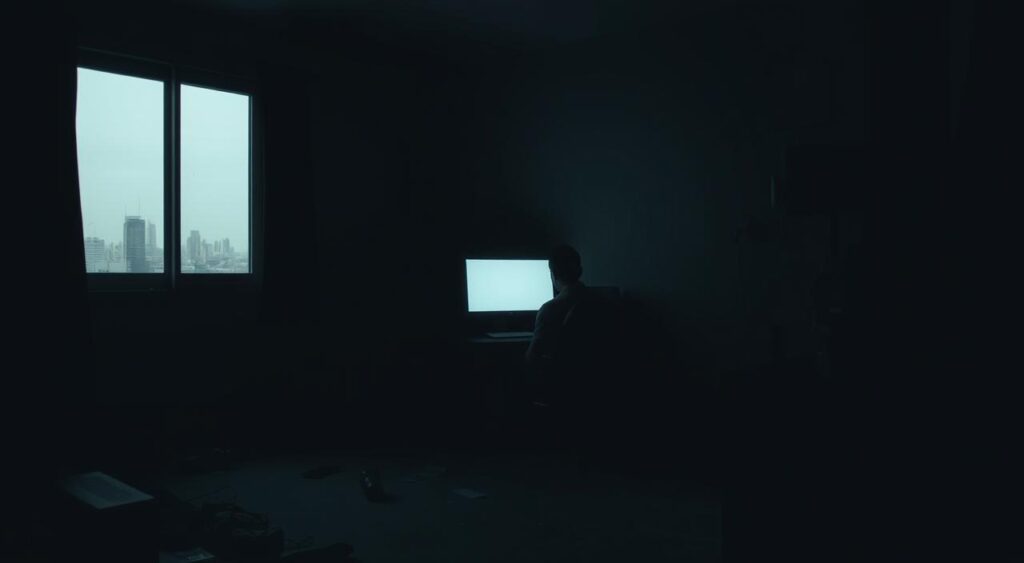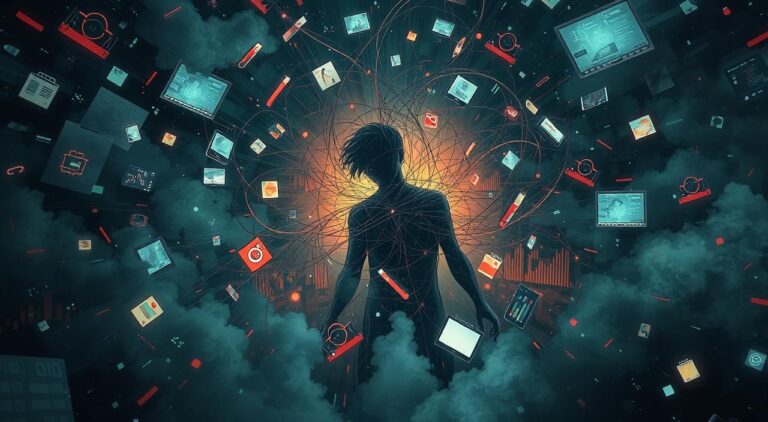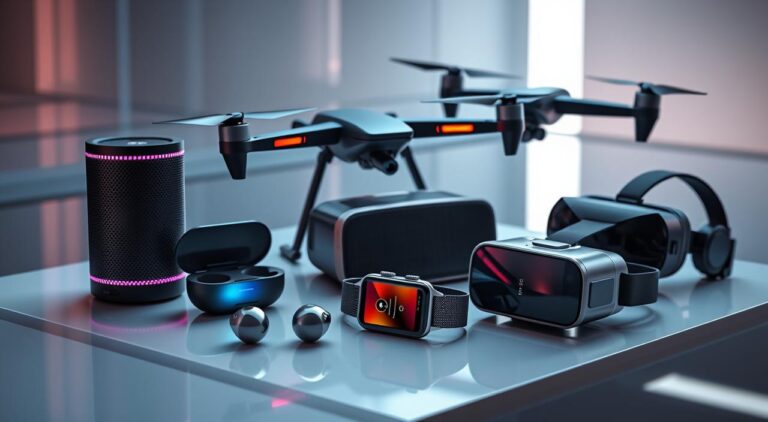
In our world filled with screens and devices, we’re facing a big concern. The health risks from technology are growing. We’re spending more time staring at screens, but are we ignoring the dangers?
What if the tools we use to make life easier are actually harming us? They could be affecting our physical, mental, and social health.
Key Takeaways
- Too much technology can harm our health in many ways.
- It can cause social isolation, depression, anxiety, and eye problems. It can also lead to poor posture, sleep issues, and less exercise.
- We need to be careful about how much technology we use, especially for kids and teens.
- But technology can also have good sides. It can help with health apps, online medical records, and better communication. We just need to use it wisely.
- To enjoy technology’s benefits, we should set limits. We should also focus on real-life connections and use parental controls.
What are the negative effects of technology on our health?
Our use of technology is growing, and so are the health risks. From eye strain to increased anxiety, the dangers are clear. Too much screen time can harm our bodies and minds.
Physical Health Implications
Looking at screens for too long can cause eye strain, headaches, and neck pain. The blue light from devices can also mess with our sleep. This affects our energy and health.
Mental Health Concerns
Using technology and social media too much can lead to depression and anxiety. It can make us feel lonely and anxious about missing out. This can harm our mental health.
Social Well-being Effects
Technology can keep us connected, but it can also make us feel isolated. Studies show that too much social media use can make us feel alone. This can lower our quality of life.
It’s important to find a balance between technology and health. Knowing the risks helps us use technology wisely. This way, we can enjoy its benefits without harming our health.
| Negative Impact | Statistic |
|---|---|
| Decline in Technology Trust | In 2020, Edelman’s Trust Barometer found a 6-point dip in worldwide technology trust to 68 out of 100, with a record low of 57 out of 100 in the US. |
| Perception of Rapid Technological Change | 61% of respondents in the Edelman Barometer 2020 thought technology was changing too rapidly. |
| Concerns about Untrustworthy Digital Content | 57% of respondents in the Edelman Barometer 2020 believed digital media platforms were full of untrustworthy material. |
| Belief in Polarization and Radicalization via Fake News | 76% of respondents in the Edelman Barometer 2020 believed fake news was being used to polarize and radicalize. |
| Social Isolation and Social Media Use | A study in the American Journal of Conflict Management found that young adults spending more time on social media are more likely to become socially isolated. |
“Technology’s negative effects on health span physical, mental, and social well-being. Physical implications include eyestrain, poor posture, and sleep disruption. Mental health concerns involve addiction, anxiety, and depression. Social well-being effects include isolation and changes in personal relationships.”
Digital Eye Strain and Vision Problems
More and more, we use digital devices for everything. This has a big impact on our eyes. Computer vision syndrome (CVS) or digital eye strain is a big problem for people of all ages. Before COVID-19, 5% to 65% of people had it. But during the pandemic, kids were especially affected, with rates up to 60%.
The 20-20-20 Rule for Prevention
The American Optometric Association has a simple solution. Every 20 minutes, take a 20-second break to look at something 20 feet away. This can help lessen eye strain and discomfort from CVS.
Symptoms of Computer Vision Syndrome
CVS symptoms include eye strain, headaches, and blurred vision. Dry eyes and neck and shoulder pain are also common. A 2016 report showed 65% of Americans had these problems. Women were more likely to experience them than men, at 69% to 60%.
Long-term Effects on Eyesight
Long-term CVS effects are serious. It can make myopia (nearsightedness) worse in kids. It can also cause new-onset myopia and other vision problems. Experts say limiting screen time to four hours a day and wearing blue-light glasses can help.
“Using digital devices continuously for two hours is sufficient to induce digital eye strain,” according to the American Optometric Association.
Good posture, regular breaks, and proper computer screen placement can help. They can reduce CVS risk and protect your eyes. Getting regular eye exams is also key if you have ongoing symptoms.
Technology Addiction and Mental Health
In our world filled with technology, it’s easy to get hooked. This addiction can harm our mental health, causing anxiety, depression, and trouble focusing. It’s a big problem.
The digital world is always competing for our attention. This constant connection can make us feel anxious, angry, or not good enough. Research shows that too much screen time can hurt our skills and empathy.
There are many types of tech addiction, like being too into social media or online games. Social media addiction can make us feel bad about ourselves. Internet gaming disorder can make us ignore important things and our health. Even problematic use of online pornography can harm our relationships and mental health.
Young people are especially at risk because their brains are still growing. Too much time on social media or video games can lead to addiction and mental health problems.
Signs of tech addiction include trouble controlling how much time we spend online and feeling bad when we can’t use it. Many factors can lead to this addiction.
To fight tech addiction, we need to use many strategies. This includes checking for addiction, talking to counselors, and finding ways to deal with other mental health issues. We also need to teach people about healthy tech use and help families set limits.
Finding a good balance with technology is key. We should use its benefits but be careful not to let it harm our mental health. By knowing the signs of addiction and taking steps to prevent it, we can have a healthier relationship with technology.
“The constant connectivity and allure of digital devices can lead to a concerning phenomenon – tech addiction, with serious implications for our mental health.”
Technology addiction can harm us physically, mentally, socially, and economically. It affects both individuals and communities. Online gambling and gaming addiction are more common than traditional addictions. Risks like sleep and eating problems are also growing.
Young people are especially at risk for tech addiction’s negative effects on mental health. We need to work together to raise awareness and find ways to help. This way, we can reduce the harm caused by tech addiction.
Musculoskeletal Issues from Device Usage
Our use of mobile devices and computers is growing. This affects our musculoskeletal health. Prolonged use can cause poor posture and musculoskeletal problems like “text neck” syndrome.
Poor Posture and Neck Strain
A 5-year study with 150 participants showed 44.7% had musculoskeletal issues. The most common were headaches (46%), neck pain (41.3%), and wrist pain (16%).
58.7% used devices for over 6 hours daily. Those who did had a 47% higher risk of musculoskeletal problems than others.
Text Neck Syndrome
“Text neck” is becoming more common, especially among the young. It’s caused by bending the neck forward while using smartphones, tablets, or computers. A study by Ogunlana et al. found neck pain was the top issue among students due to cell phone use.
Preventive Measures and Exercises
To fight these issues, we need to take steps and do exercises daily. This includes taking breaks, keeping good posture, and strengthening muscles. Gutiérrez-Puertas V et al. suggest focusing on specific groups, like nursing students, to help.
| Statistic | Value |
|---|---|
| Total Participants | 150 |
| Gender Distribution | 80% Males |
| Musculoskeletal Problems Occurrence | 44.7% |
| Specific Affected Anatomical Sites | Low back, neck, shoulder, wrist/hand |
| Common Symptoms | Headache (46%), Neck Pain (41.3%), Wrist Pain (16%) |
| Participants Using Devices for >6 Hours | 58.7% |
| Prevalence of Musculoskeletal Problems in >6 Hours Users | 47% |
| Significance Level of Comparison |
By tackling the musculoskeletal effects of our tech use, we can stay healthy. This prevents long-term problems.

Sleep Disruption and Blue Light Exposure
Technology is everywhere in our lives, affecting our sleep. Most Americans use devices close to bedtime, which can harm sleep quality. The main problem is blue light from screens, which messes with our sleep cycles.
Blue light in the evening stops melatonin release, making us less sleepy. This messes with our body’s clock, making it hard to sleep well. About half of computer users face eye problems like dry eyes and blurred vision.
Blue light does more than just disrupt sleep. It can cause permanent eye damage and raise the risk of eye diseases. Working nights can also increase cancer risks due to blue light’s effect on our body clock.
Children are especially at risk from blue light. Their eyes can’t block this light well, leading to problems like obesity and eye issues.
To fight blue light’s effects, experts say to limit screen time and avoid it before bed. This helps keep melatonin levels right, improving sleep. Blue light in the morning, however, can help with depression.
Knowing how blue light affects us can help us use technology better. We can improve our sleep and health by balancing tech use and our body’s natural rhythm.
Social Isolation and Digital Relationships
In our digital world, technology changes how we connect. Social media and online platforms were meant to unite us. Yet, they can also lead to feeling alone. A study showed young adults who use social media a lot often feel isolated.
The quality of our online interactions affects our mental health. This is key to understanding how technology impacts us.
Impact on Personal Connections
Good online interactions can help us feel less depressed and anxious. But, bad interactions and comparing ourselves to others can harm our mental health. The COVID-19 pandemic made people feel lonelier, especially those who couldn’t easily use digital tools.
Digital Communication vs. Face-to-Face Interaction
Digital relationships are easy and accessible. But, they can’t replace the closeness of meeting in person. Research shows the elderly and those with physical issues felt lonelier without in-person socializing during the pandemic. Designing technology with age in mind can help everyone feel included.
Building Healthy Online Relationships
- Use social media wisely to keep your mental health good.
- Focus on meaningful connections online, not just how many you have.
- Balance online and offline activities to stay socially engaged.
- Make sure everyone can use technology to its full potential.
Finding a balance between our digital and real-life interactions is key. By being mindful of our online relationships, we can use technology to improve our social lives and connections.

Sedentary Lifestyle and Physical Inactivity
In today’s digital world, many of our daily tech use leads to less movement. These conveniences come with a cost: they make us less active. This can harm our health.
Research reveals a big jump in obesity in the US. From under 50% in the 1960s to almost 80% today. Sadly, only about 30% of adults and 20% of teens meet exercise guidelines.
Sitting too much is linked to serious health problems. These include obesity, diabetes, high blood pressure, and heart disease. It also causes muscle loss, brain decline, and raises the risk of falls and hospital stays, especially for older folks.
But not all tech is bad for us. Fitness apps, wearables, and virtual workouts can help us move more. They can help us live healthier, more active lives and fight the dangers of sitting too much.
“Meeting physical activity guidelines results in about 75% risk reduction for all-cause mortality and a 50% reduction in cardiovascular disease mortality.”
Finding a balance between tech use and exercise is key. By adding more movement to our days and using tech to help our fitness, we can get healthier.
In summary, the rise of sitting due to tech is a big health worry. But by knowing the risks and using tech to boost activity, we can lead healthier lives. This way, we can avoid the bad effects of too much sitting.
Technology’s Impact on Child Development
Technology is everywhere in our lives today. It’s important to know how it affects kids. From phones and tablets to streaming and social media, tech changes how kids see the world. It can be good for learning and socializing, but it also has risks.
Cognitive Development Concerns
Too much screen time can hurt kids’ brains. Research shows it can cause problems with attention, language, and school grades. Tech’s constant demands can make it hard for kids to focus and think deeply.
Screen Time Guidelines by Age
- Children under 18 months: No screen time recommended
- Children 2-5 years old: No more than 1 hour of high-quality programming per day, with adult supervision
- Children 6 years and older: Consistent limits on screen time, with a focus on balancing technology use with other activities
Balancing Tech Use with Other Activities
It’s key to balance tech with other activities for kids. Encourage them to move, read, play, and talk face-to-face. These activities help their brains grow and keep them healthy.
Knowing the risks and setting limits helps kids use tech wisely. This way, they can grow and develop in a good way.
| Potential Benefits of Technology | Potential Risks of Excessive Technology Use |
|---|---|
|
|
By finding a balance and teaching healthy tech habits, we can help kids do well in the digital world. This ensures they stay healthy and happy.
Digital Wellness and Mental Health Strategies
To fight the bad effects of tech on our health, we need good digital habits. We should set limits on social media and device time. It’s also important to take breaks from screens and choose face-to-face talks over digital ones.
Doing physical activities and practicing mindfulness can lessen tech-related stress and anxiety. These steps help us feel better and more connected.
It’s vital to have a balanced life, mixing online and offline time. Being aware of our digital habits can improve our sleep, self-esteem, and fight off feelings of loneliness. This way, we can enjoy tech without harming our well-being.
Using digital wellness strategies, like the 20-20-20 rule for eye care and good posture, helps too. By managing our tech use, we can enjoy digital benefits while keeping our health safe.




